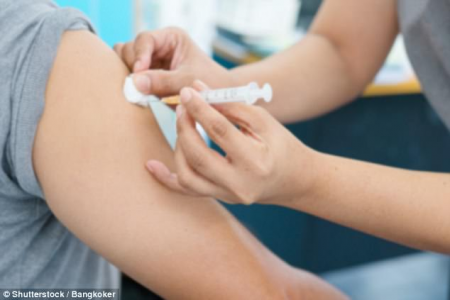Source: www.dailymail.co.uk
Author: Mia De Graaf, Health Editor
The HPV vaccine is safe and effective at preventing human papilloma virus, according to the longest investigation ever conducted on the relatively new shot. While the vaccine has been a success in every study since it came out in the US and the UK in 2006, the medical community has been keenly waiting for some long-term data to show its lingering benefits.
Today, Augusta University’s 10-year study was published in the journal Pediatrics, appearing to confirm the findings in every other short-term report. The data also supported the view that the vaccine should be administered to both boys and girls from the age of nine years old, despite previously only being offered to girls.
Experts say they hope the findings will help drive up rates of children getting the vaccine, which protects against HPV and therefore HPV-linked cancers such as throat, head, neck, penis, and cervical cancer.
‘The vaccine was virtually 100 percent effective in preventing disease in these young individuals,’ says Dr Daron G. Ferris, professor in the Department of Obstetrics and Gynecology at the Medical College of Georgia and at the Georgia Cancer Center at Augusta University.
HPV is the most common sexually transmitted infection in the US and the UK with an estimated 14 million Americans infected every year, and a third of British adults. While about two-thirds of infected individuals can eventually clear the virus, it persists and can cause a wide range of health problems in the remainder, including a whole host of cancers.
The researchers tracked 1,661 people in 34 sites across nine countries, assessing the effectiveness of the three-shot vaccine – which is the format offered in the US, while UK citizens get a two-shot vaccine.
At first, a third of the participants received a placebo. But within 30 months, they also received the vaccine. They started assessing the patients for signs of HPV – genital warts, precancerous or cancerous growths and other infections – from three-and-a-half years into the study.
Those assessments were carried out twice a year for the next seven years. But by the end of the study, all participants were still disease-free. Notably, those who received the vaccine earlier had a more robust resilience to the virus, judging by the amount of infection-fighter cells in their blood.
‘Now we need to push for more young people to get vaccinated,’ he says. ‘We are doing miserably in the United States.’
The virus is typically spread through vaginal and anal sex and can develop into cancers in the vagina, penis, throat and anus. Nearly all men and women will be contracted with one form of HPV, there are an estimated 150 types, in their lifetime, according to the CDC.
Annually an average of 38,000 cases of HPV-related cancers are diagnosed in the US. Of those cases, 59 percent are women and 41 percent are men. But men are more likely to develop a type of head or neck cancer, known as oropharyngeal squamous cell carcinoma, than women.
The CDC recommends for all children in the US to receive the vaccine between the ages of nine and 12. Forty percent of girls and 22 percent of boys aged 13 to 17 years old had completed the three-vaccine series by 2014, the organization found.
In contrast, the National Health Service in the UK recommends for only females to receive the vaccination between the ages of 12 and 13. There are no plans to extend the vaccine to males at this time because it is ‘unlikely to be cost-effective’, according to the The Joint Committee on Vaccination and Immunization.
The vaccination was first introduced for females in a three-part series to help prevent against cervical cancer that forms in the cervix. Cervical cancer occurs from genital HPV, which is skin-to-skin contact during sex.
US men are now encouraged to receive the jab after data revealed they too were at risk from developing HPV and cancers associated with the virus.
Research has also shown that men who give or receive anal sex increase their risk of developing HPV.
Condoms are a protective barrier that health experts recommend for men use in order to prevent the spread of the virus.


Leave A Comment
You must be logged in to post a comment.